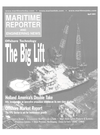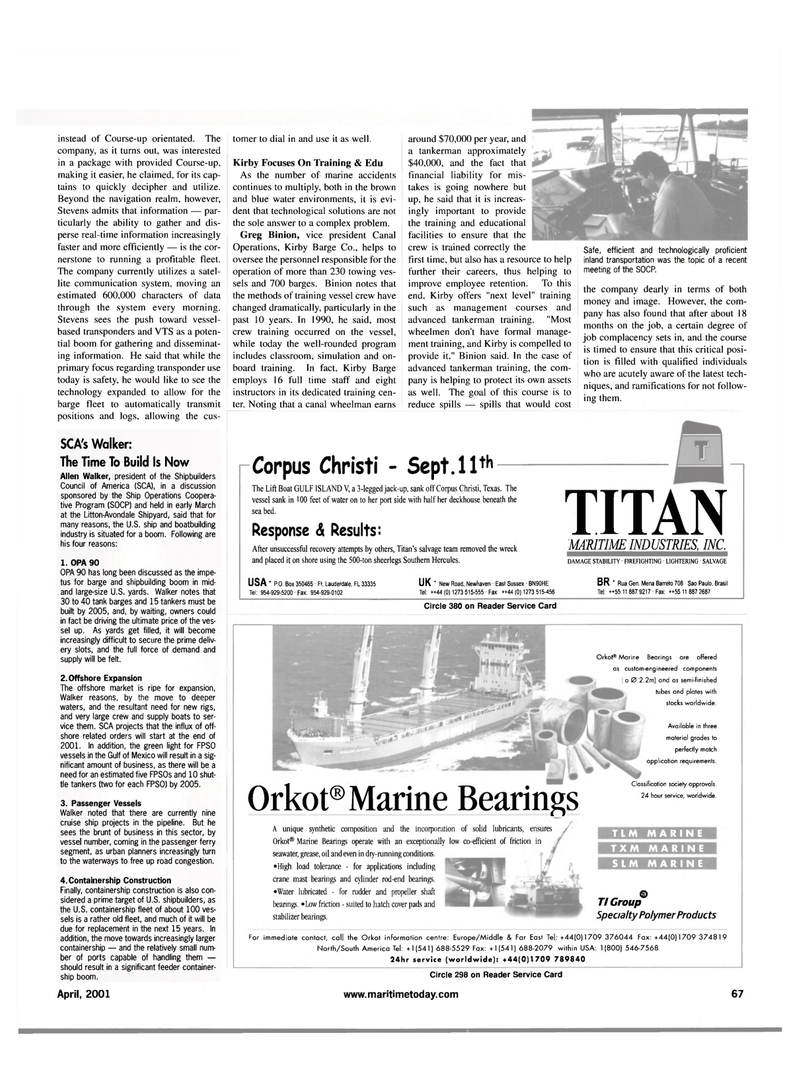
Page 67: of Maritime Reporter Magazine (April 2001)
Read this page in Pdf, Flash or Html5 edition of April 2001 Maritime Reporter Magazine
instead of Course-up orientated. The company, as it turns out, was interested in a package with provided Course-up, making it easier, he claimed, for its cap- tains to quickly decipher and utilize.
Beyond the navigation realm, however,
Stevens admits that information — par- ticularly the ability to gather and dis- perse real-time information increasingly faster and more efficiently — is the cor- nerstone to running a profitable fleet.
The company currently utilizes a satel- lite communication system, moving an estimated 600,000 characters of data through the system every morning.
Stevens sees the push toward vessel- based transponders and VTS as a poten- tial boom for gathering and disseminat- ing information. He said that while the primary focus regarding transponder use today is safety, he would like to see the technology expanded to allow for the barge fleet to automatically transmit positions and logs, allowing the cus-
SCA's Walker:
The Time To Build Is Now
Allen Walker, president of the Shipbuilders
Council of America (SCA), in a discussion sponsored by the Ship Operations Coopera- tive Program (S0CP) and held in early March at the Litton-Avondale Shipyard, said that for many reasons, the U.S. ship and boatbuilding industry is situated for a boom. Following are his four reasons: 1. OPA 90
OPA 90 has long been discussed as the impe- tus for barge and shipbuilding boom in mid- and large-size U.S. yards. Walker notes that 30 to 40 tank barges and 15 tankers must be built by 2005, and, by waiting, owners could in fact be driving the ultimate price of the ves- sel up. As yards get filled, it will become increasingly difficult to secure the prime deliv- ery slots, and the full force of demand and supply will be felt. 2. Offshore Expansion
The offshore market is ripe for expansion,
Walker reasons, by the move to deeper waters, and the resultant need for new rigs, and very large crew and supply boats to ser- vice them. SCA projects that the influx of off- shore related orders will start at the end of 2001. In addition, the green light for FPSO vessels in the Gulf of Mexico will result in a sig- nificant amount of business, as there will be a need for an estimated five FPSOs and 10 shut- tle tankers (two for each FPSO) by 2005. 3. Passenger Vessels
Walker noted that there are currently nine cruise ship projects in the pipeline. But he sees the brunt of business in this sector, by vessel number, coming in the passenger ferry segment, as urban planners increasingly turn to the waterways to free up road congestion. 4.Containership Construction
Finally, containership construction is also con- sidered a prime target of U.S. shipbuilders, as the U.S. containership fleet of about 100 ves- sels is a rather old fleet, and much of it will be due for replacement in the next 15 years. In addition, the move towards increasingly larger containership — and the relatively small num- ber of ports capable of handling them — should result in a significant feeder container- ship boom. tomer to dial in and use it as well.
Kirby Focuses On Training & Edu
As the number of marine accidents continues to multiply, both in the brown and blue water environments, it is evi- dent that technological solutions are not the sole answer to a complex problem.
Greg Binion, vice president Canal
Operations, Kirby Barge Co., helps to oversee the personnel responsible for the operation of more than 230 towing ves- sels and 700 barges. Binion notes that the methods of training vessel crew have changed dramatically, particularly in the past 10 years. In 1990, he said, most crew training occurred on the vessel, while today the well-rounded program includes classroom, simulation and on- board training. In fact, Kirby Barge employs 16 full time staff and eight instructors in its dedicated training cen- ter. Noting that a canal wheelman earns
Corpus Christi - Sept. 11th —
The Lift Boat GULF ISLAND V, a 3-legged jack-up, sank off Corpus Christi, Texas. The vessel sank in 100 feet of water on to her port side with half her deckhouse beneath the sea bed.
Response <& Results:
After unsuccessful recovery attempts by others, Titan's salvage team removed the wreck and placed it on shore using the 500-ton sheerlegs Southern Hercules.
USA • P.O. Box 350465 • Ft. Lauderdale, FL 33335
Tel: 954-929-5200 • Fax: 954-929-0102
UK • New Road, Newhaven • East Sussex • BN90HE
Tel: ++44 (0)1273 515-555 Fax: ++44(0)1273 515-456
TITAN
MARITIME INDUSTRIES, INC.
DAMAGE STABILITY • F1REFIGHTING LIGHTERING SALVAGE
BR- Rua Gen. Mena Barreto 708 • Sao Paulo, Brasil
Tel: ++55 11 887 9217 Fax: ++55 11 887 2687
Circle 380 on Reader Service Card
Circle 298 on Reader Service Card around $70,000 per year, and a tankerman approximately $40,000. and the fact that financial liability for mis- takes is going nowhere but up, he said that it is increas- ingly important to provide the training and educational facilities to ensure that the crew is trained correctly the first time, but also has a resource to help further their careers, thus helping to improve employee retention. To this end, Kirby offers "next level" training such as management courses and advanced tankerman training. "Most wheelmen don't have formal manage- ment training, and Kirby is compelled to provide it." Binion said. In the case of advanced tankerman training, the com- pany is helping to protect its own assets as well. The goal of this course is to reduce spills — spills that would cost
Safe, efficient and technologically proficient inland transportation was the topic of a recent meeting of the SOCP. the company dearly in terms of both money and image. However, the com- pany has also found that after about 18 months on the job, a certain degree of job complacency sets in, and the course is timed to ensure that this critical posi- tion is filled with qualified individuals who are acutely aware of the latest tech- niques, and ramifications for not follow- ing them.
TLM MARINE
TXM MARINE
SLM MARINE
For immediate contact, call the Orkot information centre: Europe/Middle & Far East Tel:+44(0) 1 709 376044 Fax:+44(0) 1 709 374819
North/South America Tel: +1(541) 688-5529 Fax: +1(541) 688-2079 within USA: 1(800) 546-7568 24hr service (worldwide): +44(0)1709 789840
A unique synthetic composition and the incorporation of solid lubricants, ensures
Orkot® Marine Bearings operate with an exceptionally low co-efficient of friction in seawater, grease, oil and even in dry-running conditions. •High load tolerance - for applications including crane mast bearings and cylinder rod-end bearings. •Water lubricated - for rudder and propeller shaft bearings. »Low friction - suited to hatch cover pads and stabilizer bearings. © 77 Croup
Specialty Polymer Products
Orkot® Marine Bearings
Orkot® Marine Bearings are offered as custom-engineered components o 0 2.2m) and as semi-finished tubes and plates with stocks worldwide.
Available in three material grades to perfectly match application requirements.
Classification society approvals. 24 hour service, worldwide.
April, 2001 www.maritimetoday.com 67

 66
66

 68
68
